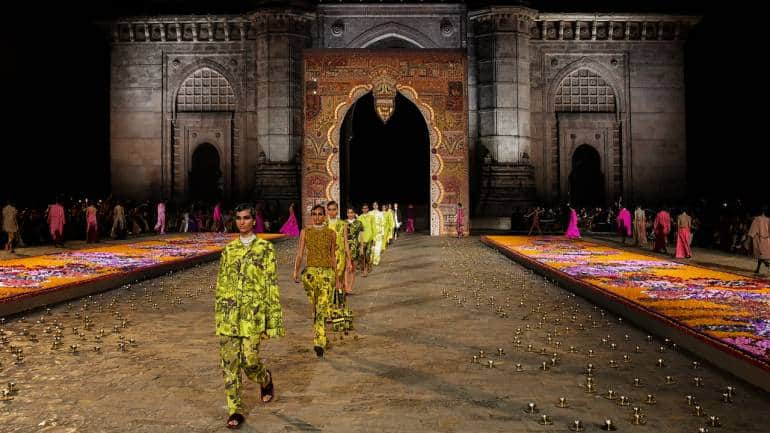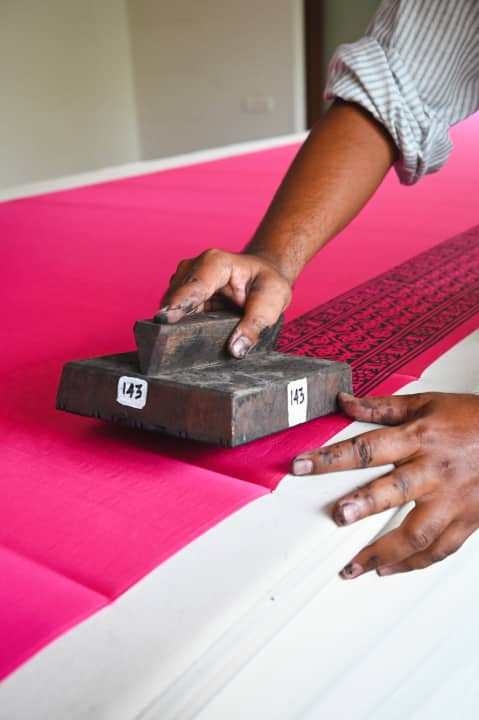



Even as the world continues to tweet/review/discuss/remain in awe of the Christian Dior Fall 2023 collection staged against the backdrop of the Gateway of India, a visible symbol of colonialism, and the Dior x Chanakya Atelier retrospective, a pertinent question being asked by those in the know is — what made Christian Dior choose India for its staging?
Or even, what made Dior agree to focus attention on its long-standing partnership with Chanakya Atelier, a global export house of the country’s craftsmanship traditions, under Maria Grazia Chiuri, Dior's Creative Director of Women's Collection?
 Christian Dior Fall 2023 show in Mumbai.
Christian Dior Fall 2023 show in Mumbai.In the past, Dior has faced accusations of cultural appropriation without giving due credit. In 2022, Chinese social media users and protestors outside one of the label’s Paris stores claimed that a $3,800 wool and mohair skirt, described by the French fashion house as a ‘hallmark Dior silhouette’, was inspired by a centuries-old Chinese garment known as a ‘Mamianqun,’ or ‘horse face skirt’.
In 2021, in India, an artisanal design studio, People Tree, took on Dior for plagiarism. Founder Orijit Sen’s work, a Yogi print design, found its way onto a Dior dress worn by Sonam Kapoor on the cover of Elle India’s January '18 edition. His daughter took to social media to call out the brand, and people who owned People Tree garments with that particular print began posting their own purchased items. As original hand-drawn artwork and hand-carved woodblock of the design made their way to social media, the brand reached an out-of-court settlement with the Delhi design studio.
Beyond these controversies, for years, Chanakya and their ustads or master artisans have been quietly working on Dior collections from a beautiful atelier located within the narrow gullies of Byculla (an old-world heritage enclave with a new sheen). But not many outside the tightly-knit artisanal studios and a small fashion clique have been aware of this fact.
That the French luxury and fashion brand, owned by LVMH, outsources a lot of the surface ornamentation and embroidery of its womenswear and its bags and shoes to an atelier in India was a well-guarded secret. A journalist who lives in a lane right behind the building housing the Chanakya Atelier commented, “They were here all the time and we had no idea!”
There could be two possible reasons for the showing, and the retrospective, then.
 Aari embroidery © Sahiba Chawdhary ©Chanaky School of Craft 9.India’s time on the luxury stage
Aari embroidery © Sahiba Chawdhary ©Chanaky School of Craft 9.India’s time on the luxury stageChristian Dior’s landmark show signals the robustness of the luxury industry in India. Suddenly, there is a slew of luxury launches. More Indians are buying brands and on the streets, in the airports, restaurants and offices, it is easy to spot Gucci, Dior or Louis Vuitton bags, shoes and accessories. A country that most luxury brands had given up on due to low consumption and high taxes is suddenly looking good.
In India, luxury shopping has jumped more than 24 percent between 2019 and 2022, as per a new report by Euromonitor’s senior research analyst Atul Sareen. India’s number of high networth individuals (HNIs) rose by 11 percent between 2020 and 2022, states the HNI Luxury Report by real estate consultancy Knight Frank.
Contrast this with declining luxury consumption in neighbouring China, one of the biggest markets for brands outside of Europe and the US. China’s personal luxury market contracted 10 percent in 2022 year-on-year, according to Bain & Company, a global management consulting firm. In Europe itself, after a huge dip due to Covid, the luxury industry has seen a V-shaped recovery, growing by 15 percent last year, which is still 11 percent lower than the 2019 level.
 From the Dior 2023 Fall CollectionGiving Indian craftsmanship its due
From the Dior 2023 Fall CollectionGiving Indian craftsmanship its dueDior’s relationship with India is far older than the age of its stores within The Taj Mahal Palace, Mumbai, and Emporia Mall, New Delhi.
Chanakya has worked over decades with Dior’s Creative Director, Women’s Collection, Maria Grazia Chiuri. The two met when Maria Grazia Chiuri was a designer at Fendi and Valentino, before moving to Dior.
Dior’s relationship with India predates her 2016 arrival at the brand. Marc Bohan, who was Dior’s artistic director from 1960 to 1989, had travelled to Mumbai and Delhi in the early 1960s to create several pieces for Indian customers. Many of the looks in the collection Maria Grazia Chiuri showed were updates of those original Bohan designs.
Karishma Swali, co-founder and creative director of Chanakya Atelier and Chanakya School of Craft, says, “We built the craft school in collaboration with Maria Grazia Chiuri to save some of the crafts that are disappearing and train women in the art of traditional craftsmanship which, till recently, was the sole preserve of men. The attempt has been to create a beautiful space filled with female creativity and energy. The women get to experiment and approach craftsmanship from different dimensions and interpret contemporary designs through our crafts.”
While Dior, like most European luxury brands, has often turned to Indian master craftsmen for their exceptional skill with embroideries and surface ornamentation, this relationship has been under the radar. Designer Rahul Mishra says that a significant portion of the international luxury industry's supply chain has always been outsourced to India.
But most brands have denied credit to Indian ateliers for their handcrafted work. Indian craftsmanship has long been unfairly spoken about as being “too kitschy” and European brands have worked hard to preserve the snob value and symbolism associated with being a ‘Made in Europe’ brand.
So, fashion insiders are calling the showing a way for Dior to say ‘thank you’ for years of collaboration on intricate couture pieces, bags and shoes. The trend for crediting Indian ateliers for their craft and handmade collaboration most likely began with the ultra-glamorous shoe and accessories brand Christian Louboutin, which spoke about their work with Vastrakala, a Chennai-based Indian-French atelier run by Frenchmen Jean-Francois Lesage and Patrick Savouret and Indian Malvika Shivakumar.
 Tie and dye work ©-Sahiba Chawdhary ©Chanaky School of Craft
Tie and dye work ©-Sahiba Chawdhary ©Chanaky School of CraftBesides Louboutin, the Chennai embroidery atelier’s work can be found in architect and decorator Robert Couturier’s collections to the king’s private chambers at the Château de Vaux-le-Vicomte near Paris, and the Monte Carlo Opera. But then one could say Vastrakala is helmed by two Frenchmen.
To showcase Chanakya’s work on Dior ramp, and to allow a rare peak into the archives of some of the work that the atelier has done for the fashion house is a very new thing and one hopes, more Indian studios that work with global brands get their due.
A day before the show, Maria Grazia Chiuri and Karishma Swali spoke to media about the long-standing collaboration. Chiuri says, “It is important to celebrate the creativity of artisans and the culture of India while offering them a contemporary flavour. This collection is a result of all the efforts we have put into bringing this (contemporary craftsmanship) language to life. While I believe India must get its due, I don’t think every embroidery atelier is at the same level of quality as Chanakya. Beautiful luxury couture has very specific needs. Excellent craftsmanship, whether it exists in Paris, Italy, Japan or India, is driven by attention to detail and the ability to experiment.”
For Swali, seeing her atelier's creations on a runway in India is a milestone in the country’s creative and cultural history. "For years, we've brought parts of Mumbai to Paris," she says. "The fact that Paris is coming to Mumbai means the world to all of us."
 At the Dior x Chanakya Atelier retrospective. (Photo: Deepali Nandwani)Chanakya x Dior retrospective
At the Dior x Chanakya Atelier retrospective. (Photo: Deepali Nandwani)Chanakya x Dior retrospectiveThe retrospective at the atelier is a rare opportunity to admire the complex pieces that Chanakya has embroidered and weaved for Dior, as well as the depth and historical significance of the atelier’s private archives of rare textiles, antiquities and craft objects from around the world.
This is the first time that Chanakya Atelier has opened its doors to visitors from India and across the world. The retrospective features pieces from 50 haute couture and prêt-à-porter collections made for Dior, and more significantly, what seems like a living museum of 12th and 13th-generation ustads (master artisans) demonstrating live the savoir-faire from the Dior Pre-Fall 2023 show.
It may seem strange to talk about Indian savoir-faire, a word not associated with craftsmanship in the country. But there it was, unfolding like poetry. Master craftsmen, and women, working on aari, zardozi, delicate-as-spider web lace, the weaving and revival of the signature Madras check, rarely-used crochet, and a variety of other embroidery techniques. You can stop, have a conversation with the artisans, understand what the technique is, and explore contemporary garments and artworks made from these embroideries. A stunning work on the atelier walls is a zardozi-embroidered canvas of the solar system.
The Dior segment of the retrospective has on display dress after dress, gown after gown, shoes and bags with exquisite embroideries. The Tree of Life motif appears on a coat from Christian Dior Haute Couture Autumn Winter 2022. On display are nuance, flamboyance, and contemporary silhouettes. “The several commissioned presentations over the years between Dior and Chanakya have been instrumental in reinventing the role of the atelier, artist and couturier,” says Swali, “and igniting a force of change and hope for those less privileged than ourselves.”
 Block printing at Chanakya Atelier in Mumbai.Christian Dior Fall 2023 collection
Block printing at Chanakya Atelier in Mumbai.Christian Dior Fall 2023 collectionChanakya’s work for the Dior Fall 2023 collection is fragile and poetic in comparison to the dense and heavy traditional zardozi or aari embroidery. Many garments are a canvas for the reinterpretation of zardozi, which is transformed into iridescent lace on a skirt-and-sleeveless top ensemble. “The interpretation of traditional craftsmanship at Chanakya lies in fragility. We keep it as light and as weightless as possible to allow the wearer to experience freedom through craft,” says Swali.
On the ramp were Madras check and Benarasi brocade fabrics, mirror work, tie-dye detailing, Nehru collars and tailored kurtas. There were geometric grids with the micro-bullion technique from the Zardozi school, and appliqué used to recreate Toile de Jouy (fabric of Jouy, a cotton or linen fabric printed with landscape scenes).
The adeptness of India’s master craftsmen, and women, at needlework was reflected in straight pants and long skirts adorned with beads and sequins. Indian symbolism was evident in the elephant or banyan tree motifs worked with the appliqué technique or mirror work in which mirrors were treated like jewels and placed all over jackets and dresses.
The moment may be historic but the collection spanned many Indian aesthetic tropes and familiar embroideries on silhouettes that were quintessential Dior. There was some amount of cliché in the form of sari-wrapped skirts and soft jackets with Nehru collars. Colours such as fuchsia, marigold and chartreuse were another attempt to capture a ‘quintessential Indian aesthetic’.
Whatever the merits and demerits of the collection, Dior’s Mumbai showing is a giant stride towards focusing attention on India’s never-credited-before contribution to the global luxury industry through its heritage of craftsmanship.
Discover the latest Business News, Sensex, and Nifty updates. Obtain Personal Finance insights, tax queries, and expert opinions on Moneycontrol or download the Moneycontrol App to stay updated!
Find the best of Al News in one place, specially curated for you every weekend.
Stay on top of the latest tech trends and biggest startup news.